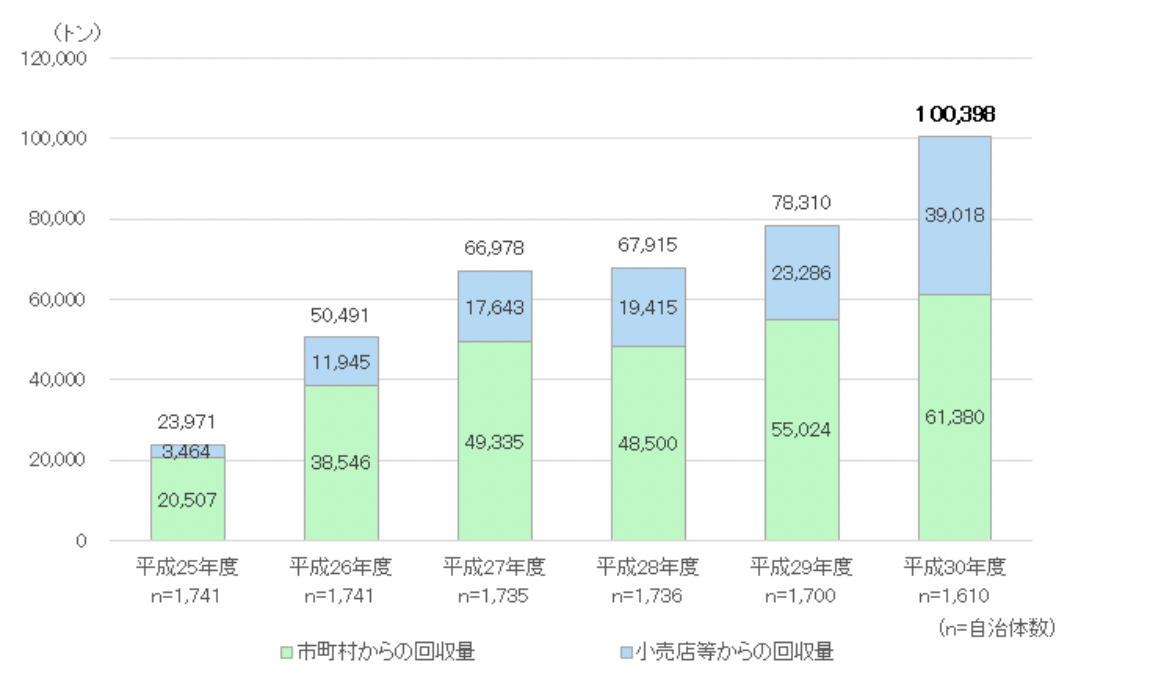課題
都市鉱山にはメリットがたくさんある一方で、多くの課題を抱えています。
回収率の低さ
「資源の現状」、「都市鉱山の意義」を読まれた方は都市鉱山の重要性がお分かりになったかと思います。 しかし日本では都市鉱山の考え方に基づく小型家電の回収はなかなか進んでいません。 実際日本は「2018年までに小型家電回収量を14万トンにする」という目標を掲げましたが、達成できませんでした。(図3.1)
Data Source : 環境省より引用
その理由の一つに知名度の低さが挙げられます。 私たちが実施した校内アンケートでは、都市鉱山について「詳しく知っている」または「少し知っている」と回答した人は35.2%でした。 都市鉱山がまだまだ広まっていないことを実感しました。 これは政府や自治体の宣伝不足にあるということは否めません。 さまざまな媒体やイベントを通して都市鉱山を広める必要があります。 中には個人情報が漏れることを気にしたり、写真を思い出として保存しておきたいと思ったりして古い携帯をリサイクルに出さないという人もいます。 しかし個人情報漏洩については回収において厳重な対策がなされており、心配する必要はありません。 また、今使っているパソコンなどにデータを移したり、クラウドに保存したりすることで、思い出を残しておくことができます。 これらのことから、家に残っている廃電子機器は積極的にリサイクルに出すべきなのです。

多くの金属を海外から輸入してきた日本には、現在豊富な金属資源 金属資源 鉱物資源の一種。さらにレアメタル、メジャーメタルに分けられる。 が残っています。 特にアンチモンは世界埋蔵量の約二割、金も一割以上と資源の可能性として無視できないほどの量になっています。 しかし、これらの資源の全てがリサイクルできるわけではありません。 これらの資源のうち管理者がいてきちんと保管されているものはリサイクルできますが、そうでないもの、例えば埋め立て地に埋められてしまったものなどはリサイクルすることが困難で、なかなかリサイクルされることがありません。 そしてこのリサイクルが困難な資源が国内の資源の多くを占めているのです。 つまり今の状態では日本はどれだけ頑張っても国内の資源の一部しか回収できないのです。 管理者のいない、リサイクルが困難な資源をいかに減らせるかということが今後の課題になっていきそうです。
コスト問題
「回収率の低さ」問題を無事にクリアして、たくさんの使用済み家電が手に入ったとしましょう。 さあ早速リサイクルだ!と言いたいところなのですが、実はそのリサイクル自体にも課題があるのです。 使用済み家電をリサイクルして資源にするのに手解体や粉砕、選別などさまざまな工程を踏まなければなりません。 特に手解体には基盤を取り出す作業があり、また、リサイクルに運ばれてくる携帯電話の種類はバラバラなので多くの人手を要します。 手解体の工程に機械を導入するという話もありますが、携帯電話はいろいろな種類がある上、情報保護のため分解しづらく設計されていることが多いのでどうしても人の手が必要なのです。 また、手解体をせずにそのまま精錬工場に送られる場合もありますが、それだと処理にかかる費用が増えてしまいます。 さらに粉砕や選別にも多くのエネルギーが消費されるので、リサイクルには莫大な費用がかかることになります。 一方で、使用済み家電には多くの種類の金属が含まれていますが、そのひとつひとつは極少量です。 そのため、使用済み家電から採れる金属の価格とリサイクルにかかるコストを考えるとリサイクルで利益を上げることは難しく、都市鉱山に関わる企業がなかなか増えないという事態になっています。 都市鉱山を広めるためには、この「コスト問題」を解決しなければならないのです。
リサイクルのリスク
都市鉱山は廃電子機器に含まれるレアメタル
レアメタル
1.地殻中の存在量が比較的少ない元素
2.単体として取り出すことが技術的に困難な元素
3.資源の産出国が偏在している
を満たす元素のことを言い、現代の産業に欠かせない”産業のビタミン”と呼ばれる。別名マイナーメタル。
やベースメタル
ベースメタル
鉄、銅、亜鉛、アルミニウムなどの精錬が容易で大量に存在する金属のこと。別名メジャーメタル
を資源として捉えるものです。
しかし、廃電子機器はレアメタルやベースメタルだけで出来ているわけではありません。
実は廃電子機器の構成成分の大部分がプラスチックで占められているのです。(図3.2)
このプラスチックがリサイクルにおける大きな問題となっています。 プラスチックのリサイクル率は世界平均で9%と低く、ほとんどが廃棄物として処理されるか、またはサーマルリサイクル サーマルリサイクル 廃プラスチックを燃焼させることで発生した燃料をエネルギーとして回収する方法。ただしマテリアルリサイクルには含まれない。 に回されています。 廃棄物として処理するにはそれなりのコストがかかる上、サーマルリサイクルに関しても排ガスや発がん性物質などの発生への懸念からあまり推奨されていません。 つまり、リサイクルは有用な金属よりもはるかに多くの廃棄物を排出し、さらにそれを適切に活用できていないのです。 また、リサイクルによって有害物質が出ることがあります。 これは廃電子機器の中に有害物質が含まれているものがあることから起こります(例えば初期のパソコンのCPUの冷却板接合には人体に有害な水銀ペーストが使われています)。 この有害物質が途上国の処分場と同じように環境を汚染しているのです。 私たちは有害物質を安定化させる処理技術を開発しなければなりません。
品位の低さ
「そもそも品位 品位 鉱石中に含まれる鉱物・金属の含有率を示す値。 って何?」と思った人もいるかもしれません。 品位とは鉱石の中に含まれている有用な元素の量を指します。 「濃度」という言葉と同じ意味だと考えてもいいでしょう。 品位が高いほど、同じ量の鉱石からより多くの有用な金属が取り出せるということです。 そして、この品位こそが都市鉱山がリサイクルするときに直面する大きな問題なのです。 それは天然鉱山と比べて品位が低いので天然鉱山との競争で負けてしまうためです。 「スマホとかパソコンの中にはいろんな金属がぎゅうぎゅう詰めになっていてむしろ品位が高いのでは?」と思う人もいるかも知れません。 その考えは正しいです。 たしかに1つ1つの製品を見れば品位は天然鉱山よりも高いです。 しかし、都市鉱山の天然鉱山との大きな違いとして天然鉱山は一つの場所に集まっているのに対して都市鉱山は各家庭に製品が分散してしまっているという点が挙げられます。 したがって都市鉱山をリサイクルする際にはまず散らばってしまっている製品を集めないといけません。 このために、1つ1つの製品で言えば品位は高いが、全体としてみると品位は低いということが起こるのです。 ただリサイクルに扱う量を増やすためというだけでなく、天然鉱山と市場で競争できるようにするためにも、回収率を上げることは解決しなければならない問題です。 この品位の低さの解決にはいかに分散を緩和するかが鍵になります。
まとめ図解
都市鉱山にはさまざまな課題が絡んでいますね... なかなか進まないこともナットクできます。
参考文献
- 『図解よくわかる「都市鉱山」開発』(原田幸明・醍醐市朗、日刊工業新聞社・2011年8月1日)
- PRTIMES「スマホのリサイクル回収率は17%。都市鉱山スマホを再資源化へ」
- 三井住友フィナンシャルグループ「「都市鉱山」に眠るレアメタルの資源化に向けて」
- NIMS「都市鉱山関係データ」
- 「都市鉱山の蓄積量推定」に関する Q&A
- petpedia「41 Eye-Opening Recycling Statistics」
- イタリア・セベソの化学工場での爆発
- 環境用語「セベソ事件」
- The New York Times「Toxic Waste Boomerang: Ciao Italy!」
- The Washington Post「AFTER DUMPING ON NIGERIA, ITALY TAKES IT ALL BACK」
- ecoo「豊島事件が残した課題」
- E-VALUE「豊島の不法投棄問題を振り返る」
Problem
Urban mining makes a lot of profit, but there are still many obstacles.
Low Collection Rate
If you read “Present Situation” and “Urban Mining”;, you should understand how important urban mining is. However, collecting on the idea of urban mining is not so active in Japan. In fact, Japan set a goal to collect 140 thousand tons of small home appliances by 2018, but they could not achieve. (Fig. 3.1)

Data Source : 環境省より引用
One of the reasons for this is lack of name recognition. In our survey at school, 35.2% of the students answered that they knew "a lot" or "a little" about urban mines. We realized that urban mining is still not widely known. It is hard to deny that this is due to the lack of promotion by the government and municipalities. They need to spread the word urban mining through various media and events. Some people do not recycle their old cell phones because they are worried about their personal information being leaked or they want to keep their photos as memories. However, they do not have to worry about leaking personal information, as strict measures are taken in the collection process. You can also preserve your memories by transferring the data to your current PC or other devices, or by storing them in your cloud. For these reasons, you should actively recycle e-waste left in your house.

Japan, which has imported many metals from overseas, has abundant metal resources metal resources A kind of mineral resource. It is further classified into minor metals and major metals. . Antimony, in particular, accounts for about 20% of the world's reserves, and gold for more than 10%, which is too much to ignore as potential resources. However, not all of these resources can be recycled. Of these resources, those that are managed and stored properly can be recycled, but those that are not, such as those that have been buried in landfills, are difficult to recycle and are not recycled very often. And these resources that are difficult to recycle account for most of the resources in Japan. In short, in its current state, Japan can only recover a part of the domestic resources however hard it tries. How to reduce the amount of resources that are not managed and are difficult to recycle is going to be an issue in the future.
Cost Problem
Suppose you have successfully overcome the "low collection rate" problem and get a lot of used appliances. You would like to say, "Let's recycle!" but actually recycling itself has its own problems. In order to recycle used home appliances and turn them into resources, various processes such as manual dismantling, crushing, and sorting must be done. In particular, manual dismantling involves taking out the base, and also requires a lot of labor because many different types of cell phones are brought for recycling. Some people have talked about introducing machines to the manual disassembly process, but since there are many different types of cell phones and they are often designed to be difficult to disassemble to protect information, manual labor is necessary. In some cases, the e-waste is sent directly to a refinery without manual dismantling, but this increases the cost of processing. In addition, a lot of energy is consumed in crushing and sorting, which makes recycling very expensive. On the other hand, used home appliances include many kinds of metals, but each of them is a very small volume. As a result, considering the price of metals extracted from used home appliances and the cost of recycling, it is difficult to make a profit from recycling, and the number of companies engaging in urban mining is not increasing rapidly. In order to spread the use of urban mines, this "cost problem" has to be solved.
Risk of Recycling
In the idea of urban mining,
minor metals
minor metals
Elements that satisfy the following conditions:
1.
relatively low abundance in the earth's crust,
2.
technically difficult to extract as a single element, and
3. unevenly distributed in resource-producing
countries.
and
base metals
base metals
A metal which is easily refined and exists a lot, such as
iron, copper, zinc, and aluminum. Also known as major
metal.
included in waste electronic equipment are regarded as resources.
However, waste electronics are not only made of minor metals and base
metals.
In fact,
the majority of the components of waste electronics are made up
of plastic. (Fig. 3.2)
This plastic causes a big problem in recycling. The global average recycling rate of plastic is low at 9%, and most of it is disposed of as waste or thermal recycling thermal recycling A method of recovering the fuel generated by burning waste plastic as energy. However, it is not included in material recycling. . It costs a lot of money to process them as waste, and thermal recycling is not recommended due to concerns about the emission of exhaust gas and carcinogens. In other words, recycling produces far more waste than useful metals, and also fails to properly use it. In addition, recycling may generate hazardous substances. This is caused by harmful substances in e-waste (For example, mercury paste, which is harmful to the human body, was used to bond the CPU cooling plates of early PCs). These toxic substances are polluting the environment as well as disposal sites in developing countries. You need to develop technologies to make toxic substances stable.
Low Grade
Some of you may be thinking, "What is grade grade A measure of the content of a mineral or metal in ore. in the first place?" The grade means the amount of useful elements contained in ore. You can think of it as the same thing as the word "content." The higher the grade, the more useful metals can be taken out from the same amount of ore. And this grade is the major problem that urban mining faces when it comes to recycling. This is because the grade is lower than that of natural mines, so it loses in competition with natural mines. Some people may think, "Isn't it rather high grade to have all kinds of metals jammed into a phone or computer?" The idea is right. It is certainly true that the grade of each product is higher than that of a natural mine. However, one of the major differences between urban mines and natural mines is that natural mines are gathered in one place, while urban mines have their products scattered around each household. This is why the grade of each product is high, but the grade of the products as a whole is low. Increasing the collection rate is a problem that must be solved, not only in order to increase the amount of waste for recycling, but also in order to be able to compete in the market with natural mines. The key to solving this low grade is how to ease the distribution.
Summary Chart
Urban mining involves a lot of issues…. You can understand that it is not easy to make progress.
References
- 『図解よくわかる「都市鉱山」開発』(原田幸明・醍醐市朗、日刊工業新聞社・2011年8月1日)
- PRTIMES「スマホのリサイクル回収率は17%。都市鉱山スマホを再資源化へ」
- 三井住友フィナンシャルグループ「「都市鉱山」に眠るレアメタルの資源化に向けて」
- NIMS「都市鉱山関係データ」
- 「都市鉱山の蓄積量推定」に関する Q&A
- petpedia「41 Eye-Opening Recycling Statistics」
- イタリア・セベソの化学工場での爆発
- 環境用語「セベソ事件」
- The New York Times「Toxic Waste Boomerang: Ciao Italy!」
- The Washington Post「AFTER DUMPING ON NIGERIA, ITALY TAKES IT ALL BACK」
- ecoo「豊島事件が残した課題」
- E-VALUE「豊島の不法投棄問題を振り返る」

